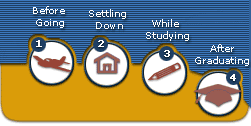 |
 |
 |
|
|
 |
|
|
 |
 |
| Privacy Policy |
| Disclaimer |
| Terms & Conditions |
 |
||
 |
Get good grades going with groovy grammar. | |
|
Grammar Tips
You use the two present tenses when you are using them. In English, there are two main ways of referring to events that happen in the present. You may say, for example, either "it is raining," or "it rains." What is the difference? In general, the "-ing" form refers to things that are happening immediately, and which are specific to the present time and place, while the other form is less specific, and refers to events or processes that are general, or continual. (Of course, there are exceptions to this rule.) If I say "it is raining" I am probably reporting today's weather. If I say "it rains" I may be making a more general point about the climate in this part of the world. For example: "Al is drinking too much tonight - he'll have a bad hangover tomorrow." vs. "Al drinks too much - I think it must be bad for his health." The word 'that', including 'that' vs. 'which' The word 'that' has many meaning. You will need to be able understand them all without needing to think about it. This confuses many people, including some native speakers. 'That' can be used:
Finally, a special (and often confusing) case is the use of 'that' to introduce restrictive clauses. 'Which' is used to introduce non-restrictive clauses. Help! What does all this mean? It's actually simpler than it sounds. If there are many cars in the parking lot, and I want to specify the car I am talking about, I will add some information, which will restrict the discussion to a more specific kind of car. So I would use a restrictive clause like this: "I am looking for the car that dented my bumper." Once I know the specific car I am looking for, I might still say something more about it, but I am no longer trying to narrow things down, so I can use a non-restrictive clause like this: "I am looking for the car that dented my bumper, which I can see from here." Finally, here's one last example of restrictive vs. non-restrictive clauses: English makes a strict distinction between singular and plural forms of words. This is called the 'number' of the noun or noun phrase. Because many non-European languages do not have such a distinction, this can be confusing. In fact, errors involving number are among the most common errors seen in international students' papers, and among the last to be fixed. The basic idea is fairly simple: you should use different forms of words when you are talking about a single item than you do when you are talking about a group of items. For example, 'item' was just used to refer to a single item, but 'items' was used to refer to several items. It is very important that the verb you use matches the number of the noun. A single duck sits and quacks, but two ducks sit together and quack. Please look again at these two cases: A duck quacks, but ducks quack. Notice that the definite article ('A') is only used with the singular form. What craziness! Crazy or not, you will need to get used to this nonsense. But wait - it's worse than that! American English is derived from several unrelated languages, each of which handled the singular/plural distinction differently, so there are many special cases to learn. The plural of 'cat' is 'cats', but the plural of 'wolf' is 'wolves', and the plural of 'deer' is 'deer'! The best thing you can do for yourself is this: Every time you learn a new English noun, you should also learn its plural form immediately. You may be surprised at how different it is. (For example, the plural of 'woman' is 'women', but the plural of 'person' is 'people'!) In fact, until you know the correct plural form of a noun, you don't really know the word at all. Adjectives are used with nouns, and adverbs are used with verbs. Be sure you know which words are adverbs, and which words are adjectives! Often, adverbs are formed by addding the letters 'ly' to the end of an adjective. For example, a stylish dancer is one who dances stylishly. But not every adverb is formed in this way. One very important example of this is the case of 'good' and 'well'. 'Good' is an adjective, used with nouns and noun phrases, but 'well' is an adverb, and so it is used with verbs. So, if things are going well at school, you might be doing well, so people might say that you are a good student who does good work. But be careful! 'Well' is also used to mean that one is in good health. So, a person who is kind might be a good person, but if they are sick and weak, they are probably not well - they may even be unwell. |

|



Home | About iStudentCity | Job Opportunities | Contact iStudentCity Hall
Copyright©2000-2009, iStudentCity.com. All Rights Reserved.